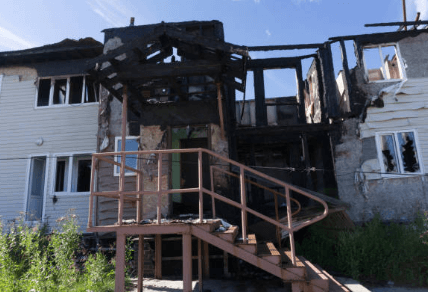Experiencing a house fire is a devastating event that can leave homeowners feeling overwhelmed and uncertain about the future. Rebuilding a House After a Fire in Florida encompasses the physical reconstruction of a residence and the emotional rehabilitation of its inhabitants. This blog will guide homeowners through the timeline of rebuilding a house after a fire in Florida, demystifying the steps from the initial damage assessment to the final touches of making your house feel like a home again. Join us as we explore the essential milestones and helpful tips to support you through this challenging time.
Steve Daria and Joleigh are seasoned real estate investors specializing in renovating homes damaged by natural disasters, including fires, in Florida. Their expertise in navigating the complex rebuilding process allows them to transform a devastating loss into an opportunity for reinvention and improvement. Drawing on their years of experience, they offer invaluable advice and support to homeowners looking to rebuild their lives and properties after a fire.
Immediate Actions Post-Fire
Before discussing the timeline of rebuilding a house after a fire in Florida, it’s essential to understand that knowing what to do when your house burns down and the proper steps can significantly impact rebuilding immediately after a fire has been extinguished.
Here are the essential immediate actions homeowners should take to set the foundation for restoring their property efficiently:
Assessing Safety and Contacting Authorities
Immediately after a fire has been extinguished, ensuring the safety of all occupants is paramount.
Homeowners should only re-enter the property once the fire department has declared it safe. Even if the fire appears to be out, hidden dangers such as weakened structural elements, residual smoke, and hot spots can pose significant risks.
Once it is safe to enter, document the scene thoroughly with photographs and videos for insurance purposes.
Contacting local authorities and your insurance company as soon as possible is crucial. They will help you file a claim and commence the restoration procedure.

Assessing Damage and Beginning Cleanup
With the property secured, a thorough damage assessment should be conducted by a professional with expertise in fire damage restoration.
This assessment will determine the extent of structural damage, smoke and soot contamination, and water damage from firefighting efforts.
Based on this evaluation, a detailed cleanup and restoration plan can be developed. Immediate cleanup efforts often involve removing debris and water extraction to avoid mold growth and additional structural damage.
The sooner these actions are taken, the more likely it is to salvage and restore affected items, and the quicker the overall rebuilding process can commence.
Example:
- Fire Damage: Severe damage to walls, ceilings, and floors.
- Smoke Damage: Pervasive odor and residue on surfaces.
- Water Damage: Resulting from efforts to extinguish the fire.
Critical Steps in Cleanup:
- Debris Removal: Clearing charred materials and damaged belongings.
- Soot and Smoke Cleanup: Using specialized techniques to remove residue.
- Water Extraction: Remove excess water and dry affected areas.
- Odor Removal: Employing treatments to eliminate smoke odors.
- Structural Repairs: Repairing or replacing damaged structural components.
- Salvaging Belongings: Cleaning and restoring salvageable items.
Get An Offer Today, Sell In A Matter Of Days...
Planning the Rebuild
The timeline for rebuilding a house after a fire in Florida is greatly influenced by the extent of the damage and the efficiency of the planning phase.
Proper planning, from securing permits to selecting contractors, can help homeowners feel prepared and in control, laying the groundwork for a smooth restoration process.
Design and Planning
Once the insurance company has assessed the damage, the next step is planning the rebuild.
This includes deciding whether to restore the house to its original state or to take this opportunity to redesign it.
Homeowners must work with architects and contractors during this phase, which can take several months of planning and obtaining the necessary permits.

Securing the Property
Securing the property is the next critical step after ensuring safety and contacting the authorities.
This involves boarding up broken windows, covering damaged roofs, and locking any accessible entry points to prevent vandalism, theft, or further weather damage.
If the property is significantly damaged, consider hiring a professional restoration company to assist with these tasks. They can provide temporary fencing, secure doors, and other measures to protect the site.
Not only does securing the property safeguard against additional loss, but it also helps comply with insurance requirements, as many policies mandate that homeowners take reasonable steps to prevent further damage.
Securing Permits
Before any construction work can begin, you’ll need to secure building permits from your local municipality.
This process can be lengthy in Florida, potentially taking several months, as it involves reviewing the rebuilding plans to ensure they meet all local building codes and regulations.
Example:
- Permit Processing: Varies by location; some areas may take longer due to specific regulations.
Rebuilding Phases
Rebuilding a house after a fire involves several phases, starting with the initial assessment and cleanup and progressing through detailed repair and final inspections.
Laying the Foundation
If the fire damages the house’s foundation, this will be the first step in the construction process.
Depending on the size and intricacy of the project, laying a new foundation or repairing the existing one can take several weeks.
Framing and Exterior Work
The next phase involves framing the house’s structure and working on the exterior, including the roof, walls, and windows.
This stage of rebuilding a home after a fire may take a few months as it sets the groundwork for the rest of the restoration.
Interior Finishing
After completing the exterior work, the focus shifts to the interior. This includes installing insulation, drywall, flooring, and fixtures.
Interior finishing is a detailed phase, generally taking several months to ensure the house is livable and meets the homeowner’s standards.
Final Touches
The last phase of rebuilding a house after a fire involves painting, installing appliances, and finishing touches.
This phase can take a few weeks to a month and culminates in the completion of the restoration process.
Frequently Asked Questions
Rebuilding a house after a fire in Florida comes with questions and concerns.
Below are the top frequently asked questions aimed at assisting homeowners navigate the challenging process of reconstructing their homes and lives.
How long does it take to rebuild a house after a fire in Florida?
The entire process can take several months to a year or more, depending on various factors such as the extent of the damage, design plans, permit approvals, and construction work.
Can I live in my house while it’s being rebuilt?
Living in a house being rebuilt after a fire is usually unsafe or impractical.
Until the restoration is complete, alternative accommodation should be arranged.
How can I ensure the rebuild process goes smoothly?
Working with experienced professionals, maintaining open communication with your insurance company, and being actively involved in the design and planning stages can help ensure the rebuild process goes as smoothly as possible.
What steps can I take to prevent future fires?
Implement fire-resistant materials during the rebuild, ensure your home has functional smoke detectors, and regularly review and practice fire safety protocols to help prevent future fires.
Conclusion
Rebuilding a house after a fire in Florida is daunting but navigable. It requires diligence, patience, and effective collaboration with various professionals. By understanding the timelines and critical steps involved, homeowners in Florida can prepare for the road ahead, ensuring a smoother transition back to normalcy. Remember, rebuilding a house after a fire is not just about restoring a physical structure but reclaiming a sense of home and security for you and your loved ones.
**NOTICE: Please note that the content presented in this post is intended solely for informational and educational purposes. It should not be construed as legal or financial advice or relied upon as a replacement for consultation with a qualified attorney or CPA. For specific guidance on legal or financial matters, readers are encouraged to seek professional assistance from an attorney, CPA, or other appropriate professional regarding the subject matter.

